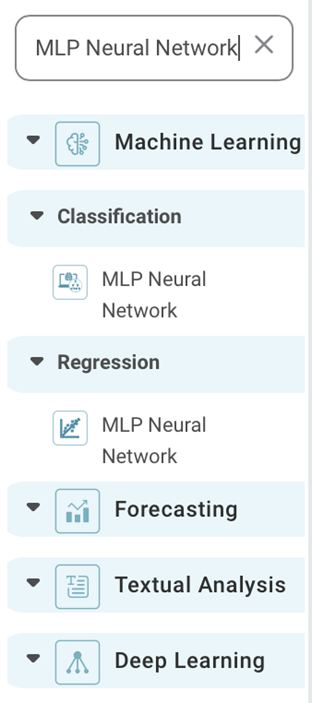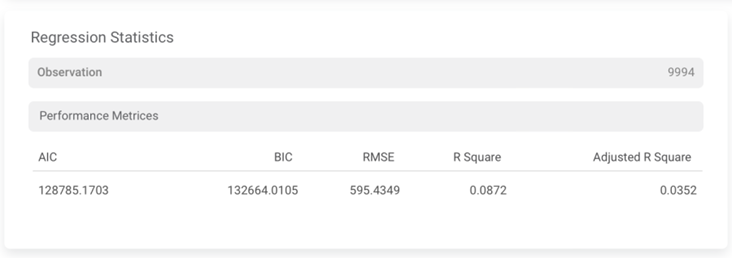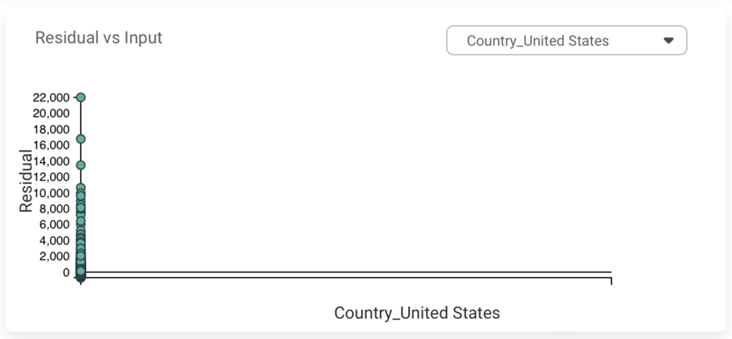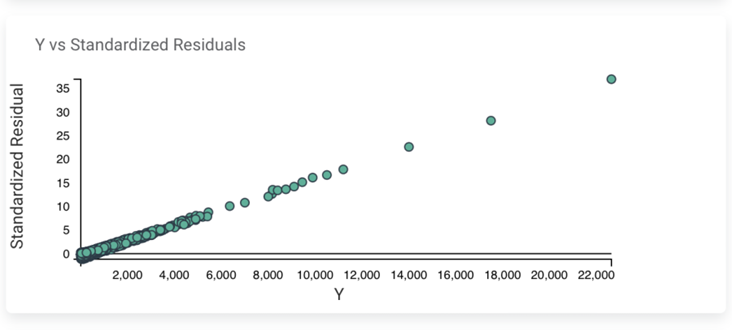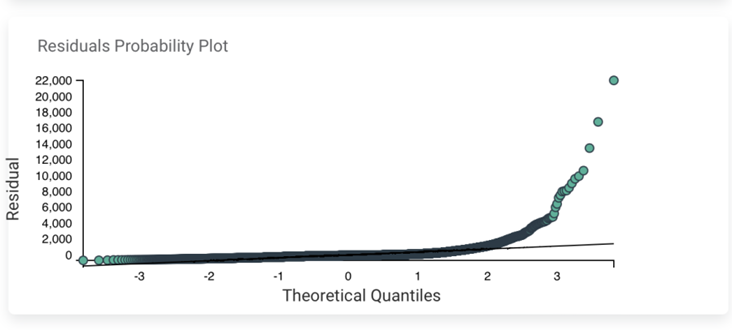MLP (Multi-Layer Perceptron) Neural Network in Regression | |||
Description | An MLP neural network for regression is designed to predict continuous numerical values. It consists of multiple layers, including an input layer, one or more hidden layers, and an output layer. Each layer contains neurons that process the input data and apply activation functions. The network's weights and biases are adjusted during training to minimize the difference between predicted and actual values. | ||
Why to use | 1. Non-Linear Mapping | ||
When to use | 1. Non-linear Relationships | When not to use |
|
Prerequisites | 1. Feature Selection or Extraction | ||
Input | Choose a continuous dependent variable (column) and select a specific number (n) of independent variables (columns) with either categorical or numerical types. | Output | 1. AIC |
Statistical Methods Used | 1. Mean Squared Error (MSE) | Limitations | 1. Overfitting |
The MLP Neural Network is located under Machine Learning in Regression, on the left task pane. Alternatively, use the search bar for finding the MLP Neural Network algorithm. Use the drag-and-drop method or double-click to use the algorithm in the canvas. Click the algorithm to view and select different properties for analysis.
An MLP (Multi-Layer Perceptron) neural network in regression refers to a specific type of neural network architecture used for regression tasks. The MLP is designed to predict continuous numerical values as the output.
The MLP consists of multiple layers, including an input layer, one or more hidden layers, and an output layer. Each layer contains a set of interconnected neurons, also known as perceptrons or nodes.
The MLP learns to map the input features to the desired continuous output by adjusting the weights and biases associated with the connections between neurons. These adjustments are made iteratively using optimization algorithms, such as backpropagation, to minimize the difference between the predicted output and the actual target values.
Each neuron in the hidden layers and the output layer applies an activation function to the weighted sum of its inputs. The activation function introduces non-linearities into the model, allowing it to capture complex relationships and patterns in the data.
The MLP can be used to make predictions on new, unseen data. The input features are fed into the network and propagated through the layers. The output value is obtained from the output neuron of the MLP.
Properties of MLP Neural Network in Regression
The available properties of MLP Neural Network are as shown in the figure given below:
Field | Description | Remark | |
Task Name | It displays the name of the selected task. | You can click the text field to modify the task name as required. | |
Dependant Variable | It allows you to select the dependent variable. | You can select only one variable, and it should be of | |
Independent Variable | It allows you to select the independent variable | You can choose more than one variable. | |
Advanced | Learning_rate | It allows you to select the constant, in-scaling, or adaptive learning rate. | It is a hyperparameter that controls the step size at which the weights and biases of the network are updated during the training process. |
Learning_rate_init | It allows you to enter the learning rate value. | It refers to the initial learning rate used at the beginning of the training process. | |
Hidden Layer Sizes | It allows you to enter the number of hidden layers. | It refers to the number of neurons or units in each hidden layer of the network. | |
Activation | It allows us to choose no-op, logistic sigmoid, hyperbolic tan, and rectified linear unit functions. | It is a mathematical function applied to the weighted sum of the inputs to each neuron in a hidden layer or the output layer. | |
Solver | It allows us to choose lbfgs, sgd, and adam. | It refers to the optimization algorithm used to update the weights and biases of the network during the training process. | |
Maximum Iterations | It allows us to enter the number of iterations. | It refers to the maximum number of iterations or epochs that the training process will run. | |
Random State | It allows us to enter the number of random states we want. | It is a parameter that controls the random initialization of the network's weight and biases. | |
Power_t | It allows us to select the power level. | It determines the convergence criterion for the optimization algorithm. | |
Dimensionality Reduction | It allows you to select between None and PCA. | It to the process of reducing the number of input features or variables in a dataset while preserving the important information and patterns present in the data. | |
Example of MLP Neural Network
In the example given below, the MLP Neural Network Regression is applied to the Superstore dataset. The independent variables are Country, City, and Category, etc. Quantity is selected as the dependent variable.
The result page displays the following sections.
Section 1 - Event of Interest
Performance | Description | Remarks |
AIC | AIC is an estimator of errors in predicted values and signifies the quality of the model for a given dataset. | A model with the least AIC is preferred. |
Adjusted R-Square | It is an improvement of R Square. It adjusts for the increasing predictors and only shows improvement if there is a real improvement. | Adjusted R Square is always lower than R SquareAdd another point as adjusted r Square also considered maximum value which shows the model is the perfect fit for this data. Same for R square. |
BIC | BIC is a criterion for model selection amongst a finite set of models. | A model with the least BIC is preferred. |
R-Square | It is the statistical measure that determines the proportion of variance in the dependent variable that is explained by the independent variables. | Value is always between 0 and 1. |
RMSE | It is the square root of the averaged squared difference between the actual values and the predicted values. | It is the most commonly used metric to evaluate the accuracy of the model. |
Section 2 – Regression Statistics
Section 3 – Residuals Vs. Inputs
Section 4 – Y Vs. Standardized Residuals
Section 5 – Residuals Probability Plot
Table of Content
